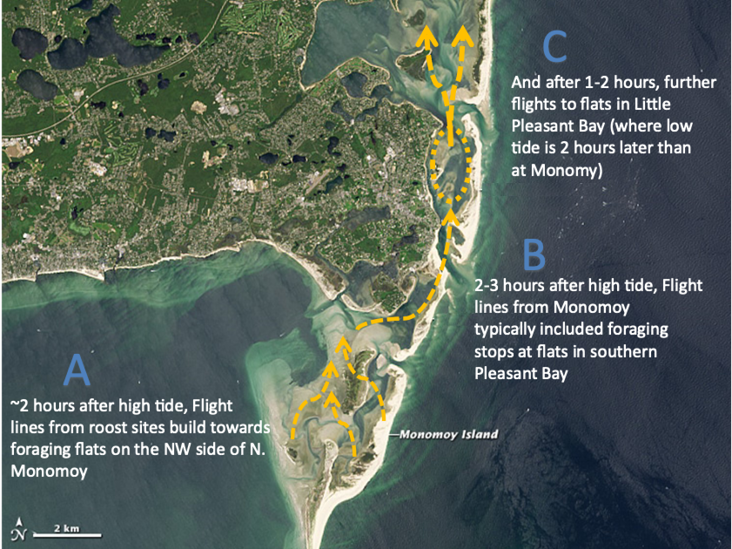Brian Harrington

Figure 1. Principal foraging areas of shorebirds from roosting areas at Monomoy National Wildlife Refuge. Modified from Google Earth. Map Data: 12/14/2015–5/2/2023.Google, AirbusData SIO, NOAA, U.S. Navy, NGA, GEBCOTerraMetrics/
Introduction
The Orleans and Chatham region of Cape Cod—especially Monomoy National Wildlife Refuge (MNWR)—is a world-renowned refueling station for shorebirds as they migrate between their Arctic breeding areas of Alaska and Canada and their wintering places, which for some species may be as distant as the southern tip of South America. Many of the 35 species of shorebirds that visit Cape Cod in fall subsequently fly nonstop over the ocean between Cape Cod and South America. The fuel they gain at places such as Pleasant Bay and MNWR is critical to the success of these migrations.
MNWR is recognized by the Western Hemisphere Shorebird Reserve Network (WHSRN) as a key migration staging area (Harrington and Perry 1995) with its designation as a site of regional importance <https://whsrn.org/whsrn_sites/monomoy-nwr>. In this report, we argue that MNWR qualifies as a site of International Importance based on the number of shorebirds estimated to have used the refuge during 2021 and 2022, and almost certainly for decades before 2021.
The daily routines of shorebirds while in the Monomoy region are largely dictated by tide. At lower tides they disperse over thousands of acres to forage on intertidal sand and mud flats, whereas during higher tides, when the flats are inundated, they flock by thousands to much smaller roosting locations. Roosting and foraging locations can be separated by miles, with shorebirds from MNWR commuting to flats as distant as Little Pleasant Bay (Figure 1); some shorebirds travel to the enormous tidal flats of eastern Cape Cod Bay.
Most of the shorebirds foraging in the Chatham and Orleans region roost within the MNWR (this report); this is the time when they can most effectively be counted. During 2022, we typically counted roosting shorebirds within two hours of high tides.
To view the rest of the article you'll need to
subscribe. Bird Observer publishes original articles on birding locations, on avian populations and natural history, on regional rarities, field notes, field records, photographs, and art work.